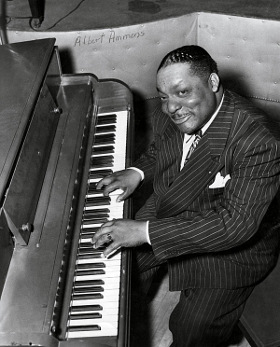Albert Ammons facts for kids
Quick facts for kids
Albert Ammons
|
|
|---|---|
 |
|
| Background information | |
| Birth name | Albert Clifton Ammons |
| Born | March 1, 1907 Chicago, Illinois, U.S. |
| Died | December 2, 1949 (aged 42) Chicago, Illinois, U.S. |
| Genres | Jazz, blues, boogie-woogie |
| Occupation(s) | Musician |
| Instruments | Piano |
| Years active | 1920s–1949 |
| Labels | Blue Note, Delmark, Mercury, Vocalion, Solo Art, Victor, Decca, V-Disc, Commodore |
Albert Clifton Ammons (born March 1, 1907 – died December 2, 1949) was an American piano player. He was famous for playing boogie-woogie music. Boogie-woogie is a fast and lively style of blues music that was very popular from the late 1930s to the mid-1940s.
Contents
Albert Ammons's Life and Music Career
Ammons was born in Chicago, Illinois. His parents both played the piano, and he started learning when he was just ten years old. He became very interested in boogie-woogie because of his close friend, Meade Lux Lewis. His father also loved this style of music. Albert and Meade would often practice together on the piano at Ammons's house.
Learning to Play Piano
When he was ten, Ammons learned about musical chords by marking the keys on his family's pianola (a player piano) with a pencil. He kept doing this until he understood how to play them well. As a teenager, he also played drums in a drum and bugle corps. Soon, he was playing with bands in clubs around Chicago. After World War I, he became very interested in the blues. He learned by listening to other Chicago pianists like Hersal Thomas and the brothers Alonzo and Jimmy Yancey.
Early Career and Bands
In the early 1920s, Ammons worked as a taxi driver. In 1924, he met his childhood friend Meade Lux Lewis again, who was also a taxi driver. Soon, the two friends started playing music together at club parties.
In 1934, Ammons started his own band at the Club DeLisa. He stayed there for two years. His band had five members, including Guy Kelly, Dalbert Bright, Jimmy Hoskins, and Israel Crosby. Ammons also recorded music with his band, called Albert Ammons's Rhythm Kings, for Decca Records in 1936. Their song "Boogie Woogie Stomp" was very important. Many jazz bands later copied this song.
Moving to New York and Famous Concerts
Ammons moved from Chicago to New York City. There, he joined another piano player named Pete Johnson. They often played together at the Café Society. Sometimes, their friend Meade Lux Lewis or other jazz musicians like Benny Goodman and Harry James would join them.
On December 23, 1938, Ammons, Johnson, and Lewis played a big concert at Carnegie Hall. The concert was called From Spirituals to Swing. It was put on by John H. Hammond. This concert helped make boogie-woogie music very popular. Two weeks later, a record producer named Alfred Lion started Blue Note Records. He recorded nine solo songs by Ammons, including "The Blues" and "Boogie Woogie Stomp." He also recorded songs by Lewis and two duets.
Later Years and Legacy
In 1941, Ammons's boogie-woogie music was used in a short animated film called Boogie-Doodle. Ammons also played himself in the movie Boogie-Woogie Dream (1944), which starred Lena Horne and Pete Johnson. In the 1940s, Ammons recorded music with his son, Gene Ammons, who played the tenor saxophone.
Even though boogie-woogie music became less popular around 1945, Ammons still found plenty of work. He kept touring and playing music by himself. Between 1946 and 1949, he recorded his last songs for Mercury Records. He also worked as a staff pianist with the Lionel Hampton Orchestra. In 1949, he even played at the inauguration of President Harry S. Truman.
In his last years, Ammons mostly played at clubs in Chicago. Just four days before he passed away, he was listening to Don Ewell and Jimmy Yancey play. Ammons could only play one song himself because he had just gotten back the use of his hands after being temporarily paralyzed.
Ammons died on December 2, 1949, in Chicago. He was almost 43 years old. He was buried at the Lincoln Cemetery in Blue Island, Illinois.
Albert Ammons's Influence on Music
Albert Ammons had a huge influence on many piano players. Some famous musicians he inspired include Jerry Lee Lewis, Dr. John, Erroll Garner, and Ray Bryant. A German pianist named Jörg Hegemann even made an album called A Tribute to Albert Ammons to honor him on his 100th birthday.
Albert Ammons's Music
Notable Songs
- "Boogie Woogie Stomp"
- "Boogie Woogie Prayer"
- "Shout for Joy"
- "Woo-Woo" (1939)
See Also
 In Spanish: Albert Ammons para niños
In Spanish: Albert Ammons para niños
- List of blues musicians
- List of boogie woogie musicians
- List of jazz pianists
- List of Mercury Records artists

